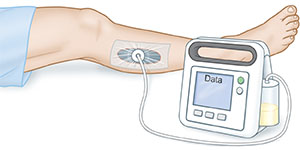WHAT YOU NEED TO KNOW: What is negative pressure wound therapy (NPWT)? NPWT uses a machine called a wound vac, wound vacuum, or pump to help with wound healing. Suction from the machine removes excess drainage from your wound and pulls wound edges closer together. NPWT promotes healthy tissue growth by increasing blood flow to your wound. NPWT also reduces bacteria that causes infections. You and your healthcare providers will be taught about your specific NPWT machine, alarms, and dressing changes. 
|
How does NPWT work? Moist foam packing or gauze is placed in your wound. Suction tubing may already be implanted within the foam. If not, tubing will be placed in the middle of the foam or gauze. Then your wound and part of the tubing will be covered completely by a clear dressing. The tubing is attached to a collection canister on the machine. Your healthcare provider may set the machine for continuous or periodic suction. When the suction is turned on, the foam packing and wound will contract (tighten) and bring the wound edges together. For what conditions is NPWT commonly used? - Wounds that have been slow or difficult to heal
- Pressure ulcers
- Diabetic ulcers
- Skin grafts or flaps
- Chest and abdominal wounds
What else do I need to know about NPWT? - NPWT is used 24 hours a day. If the NPWT machine is turned off for 2 hours or more, the dressing needs to be replaced. Ask your healthcare provider what type of dressing to use.
- You can shower with the dressing in place. Do not remove your dressing unless directed. Ask your healthcare provider for more information. Do not take the machine into the bathtub or shower with you. Ask your healthcare provider about taking a shower.
|